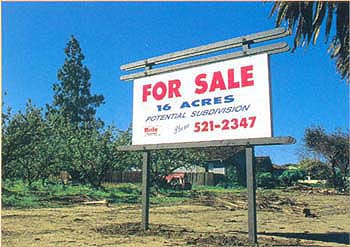All Issues
Central Valley leaders cautious about agricultural easements
Publication Information
California Agriculture 56(1):22-23. https://doi.org/10.3733/ca.v056n01p22
Published January 01, 2002
PDF | Citation | Permissions
Full text
THE Central Valley is the premier agricultural region in California. But it lags far behind central coastal areas in the accumulation of agricultural easements, an increasingly popular technique for protecting farmland through voluntary landowner action. The 18-county Central Valley has far fewer established local easement programs, participating landowners and agricultural acres under easement than a group of five coastal counties from Sonoma to the north to Santa Barbara to the south. The entire Central Valley in mid-2000 contained only 15% (13,100 acres) of the state's total 84,000 acres under agricultural easements, as compared with 70% (59,000 acres) for the coastal counties.
To investigate the prospects for greater use of agricultural easements in the Central Valley, we interviewed 111 community leaders in 11 Central Valley counties, in 1999 and 2000. The respondents were county and city planning directors, leaders of county Farm Bureau organizations, agricultural commissioners, building industry leaders, agricultural bankers, land appraisers and community activists. In open-ended interviews, mostly in person and averaging about 40 minutes, we asked their familiarity with the technique, its merits, possible local applications and a range of other questions. Not all interviewees responded to all questions.
In California's agriculturally rich Central Valley, community leaders had generally positive impressions about easements but there were few enthusiastic supporters. In Patterson, land was offered for subdivision.
While the results are not directly comparable to interviews conducted with landowners involved in three major easement land-trust programs in the northern Bay Area and Yolo County, the findings suggest important regional differences. Most notably, Central Valley respondents expressed more cautious views about use of easements to protect farmland.
Survey synopsis
Familiarity
About four fifths of respondents were generally familiar with the easement technique, with most reporting an elementary level of knowledge. Planners, land appraisers and agricultural commissioners tended to be the most knowledgeable, with bankers and building industry people the least.
Positive impressions
As to whether easements on farmland are a “good idea” in concept, positive responses outranked negatives 32 to 5. But a larger number (50) said “maybe” or expressed some uncertainty, citing issues of funding, location, relation to planning tools and community support (N = 87).
Local impact
As to whether easements are a “good idea” for respondents' particular localities, responses were positive by 51 to 34, with another 34 indicating conditional approval (N = 90).
Pros and cons
Benefits to landowners topped the list of advantages, while problems with location and perpetuity were tied for top disadvantages (fig. 1).
Perpetuity
There was a 19 (pro) to 15 (con) split on whether easements should last in perpetuity, with another 13 respondents having positive but cautious views (N = 47).
Nonprofits
By a 46 to 11 margin, respondents favored nonprofit land trusts over public agencies to manage easement programs (N = 57).
Priorities
Location in relation to urban growth was mentioned by 37 respondents as an important priority for programs acquiring easements, while 19 each cited quality of land or multiple priorities (N = 75).
Consideration of easements
We also asked 33 farmland owners, mostly local Farm Bureau leaders, whether they would be interested in selling easements on their agricultural land. This was clearly a hypothetical question, since all but one of the interviewees had never had the opportunity to consider an easement sale. And in all but two or three cases, the farmland they owned was distant from the nearest urbanization and had virtually none of the development potential that programs frequently seek as a qualification for an easement acquisition. Nonetheless, the responses were mixed: 16 yes, 8 no, 9 maybe.
One Kings County farmer we interviewed said: “I manage 40 acres in walnuts for a family group. It's not really close to development. But some of my brothers think that there will be a shopping center out there in about 40 years, and so they're betting on the future. I don't think that's realistic. But no, we would not be interested in getting into an easement.”
Another in Kern County noted: “I would have to bring the family together and say, ‘Would you be interested in doing this sort of thing?’ We all have our homes here. There are three of us. I'd have to get them to think about the future. Do they really want to hold on to this facility?”
Positive but cautious
In general, the Central Valley leaders were mildly positive but cautious about the merits of agricultural easements and the possibility of expanding their use in California's premier agricultural region. Few respondents rejected the technique outright. But there also were few enthusiastic supporters. A high degree of uncertainty ran through the responses, with questions raised about perpetuity and other practical issues.
In responding to our questions, many interviewees may have been constrained by limited knowledge about the workings of the easement technique. Improving this knowledge base is the goal of several organizations with educational activities in the region, notably the Great Valley Center, American Farmland Trust and California Department of Conservation. The more critical limitation, however, may be the absence of functioning agricultural easement programs in most parts of the Central Valley, perhaps the result of limited citizen interest and local government support (see p. 15 ).






